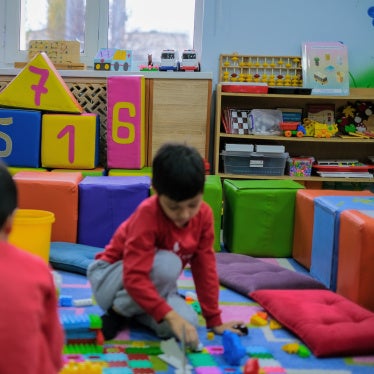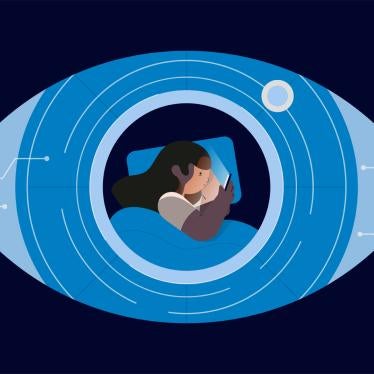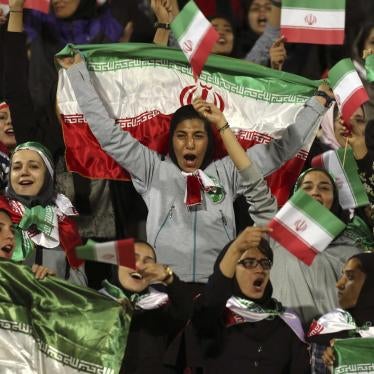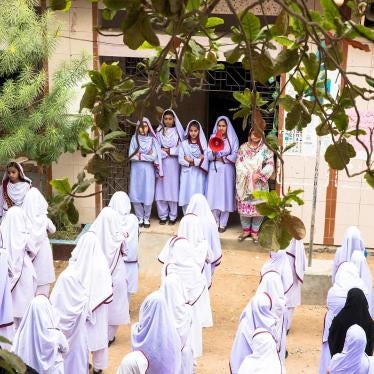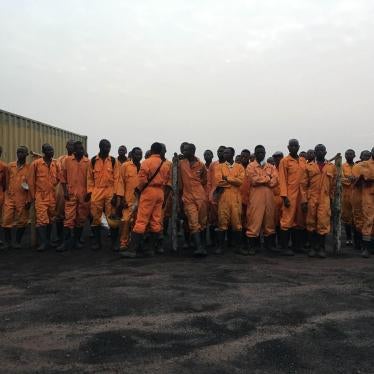Human Rights Watch urges the prompt drafting of an optional protocol to the Convention on the Rights of the Child to realize the aims laid out in Human Rights Council resolution 56/5.
1. Barriers to public pre-primary education available free to all in law, policy, and practice
Although at least 68 percent of national constitutions explicitly protect the right to primary education, constitutional references to early childhood education are almost non-existent.[1] This mimics the distinction under the Convention on the Rights of the Child, where a right to free primary education is explicitly guaranteed, but there is no mention of either early childhood education or pre-primary education.
According to UNESCO, at least 89 countries guarantee in law at least one year of free pre-primary education, with some offering four years. However, this indicates that 70 percent of the world’s children live in countries without such a guarantee.[2] Additional countries provide free pre-primary education through policy, which is more susceptible to being reversed than if protected in law.
When pre-primary education is not available free, cost prevents children from low-income families from participating. In Sri Lanka, a preschool teacher reported to Human Rights Watch in 2025 that students must pay 1000 LRK (US$3.50) monthly. When families cannot pay, children do not come “for some months,” she said. In January 2025, only 3 out of 20 students in her class paid.[3] A Sri Lankan education officer said, “If you can’t afford to pay there is no space in the system… Only the families that have money can send their children to preschool.”[4]
In Uganda, the government does not provide public pre-primary, and fewer than 1 in 10 children ages 3-5 are enrolled in a formal pre-primary school. A motorcycle taxi driver said he wanted to send his 5-year-old to a nearby pre-primary, but “I don’t have money… There are these people who are rich who are taking their children to school. For the poor, things remain like that.”
Syrian refugee families in Jordan told Human Rights Watch in 2015 that they had tried to put their children in pre-primary school but could not afford the costs. An unemployed former truck driver, who had run out of savings, said he wanted to send his youngest son to pre-primary education, but could not afford the fees. He said he was “afraid” for his son’s future.
When countries introduce free pre-primary, more children participate. Ireland expanded free preschool to children aged 4 in 2010, and enrollment quickly became almost universal. When Azerbaijan adopted legislation providing three years of free pre-primary education, participation rates shot up from 25 percent to 83 percent in four years. Armenia and Uzbekistan also saw large increases in pre-primary participation after adopting laws to expand free pre-primary.
Available public education is important to achieve universal access. The Initiative for Social and Economic Rights (ISER) Uganda and Human Rights Watch found that in Uganda, private pre-primary schools clustered in urban areas with higher-income families, where such businesses are more easily guaranteed adequate income. In 2019, the adjusted net attendance rate of 5-year-olds was 17 points higher in urban areas than in rural areas.
Impact on the rights of the child
Quality pre-primary education builds cognitive, social, and emotional skills during the most formative years. A mother in Poland explained why she sent her son to kindergarten: “He’s an active child, he can’t stay in one place… Children just develop better in kindergarten. I can do something with them too, but it’s not the same. They know how to deal with them.”[5]
A parent in Uganda said, “Everything in this world has a foundation. Without a foundation, it is weak, and it will collapse. It is important to have a foundation for education and that is nursery [pre-primary].” Teachers echoed this, saying pre-primary participation helped young children’s successful transition to primary education. One said: “Those who attended nursery education are always far better than those who missed nursery learning.” Another said: “When you compare the literacy competence of those who attended pre-primary and those that did not, there is a difference.” A survey by Makerere University found that students with 13 to 24 months of pre-primary education had better reading and numeracy skills in grade 6 than peers without.
A manager of a primary school in an area in Sri Lanka with high levels of children living in poverty said that 70 percent of incoming students had not benefited from any pre-primary education, and cited this as a reason for them facing learning challenges once in primary.[6]
In Uganda, many parents enroll their underage and unprepared children in free primary school to avoid pre-primary costs. Data show that 20 percent of Ugandan children aged 5 are already enrolled in primary school, which should start at age 6. Early enrollment creates overcrowded classes, exacerbates inefficiencies in the education system, and increases repetition rates. UNICEF estimates that excessive repetition wastes up to 10 percent of the education budget.
Pre-primary can be beneficial for children with disabilities, including by strengthening their capacity to benefit from education, promoting their enrollment and attendance, and reducing stigmatizing and discriminatory attitudes against them. A Polish mother of a 3-year-old with cerebral palsy said attending kindergarten was “good for her, it allows her to develop better and she has different therapies in the kindergarten that will help her develop and grow.”[7]
2. Barriers to public secondary education available free to all in law, policy, and practice
Constitutional protections for secondary education also lag behind those for primary: under half of national constitutions guarantee it, and only 30 percent mandate it be tuition-free. Again, this disparity mimics the lesser status of secondary education in international law.
According to UNESCO, at least 97 countries guarantee by law 12 or more years of free primary and secondary education. However, this indicates that around 64 percent of the world’s children live in countries without such a guarantee.[8] Additional countries provide free secondary education only through policy, which is more susceptible to changes based on political agendas.
Human Rights Watch analyzed 107 countries with GDP per capita of $14,000 or less—59 of which offered 11 or 12 years of free primary and secondary education, and 48 that did not offer full free secondary education.[9] In countries providing 11-12 years of free primary and secondary education, completion rates were significantly higher (52 percent) compared to countries without free secondary (39 percent), even after controlling for GDP per capita, enrollment rates, education expenditure, and teacher-student ratios. To achieve the same 13 percentage point increase in completion rates through economic growth alone, a country would need to increase its GDP per capita by approximately $9,100, which could take years or even decades.
Some countries that ostensibly offer free secondary education nonetheless do not provide schools enough in capitation grants (a fixed amount per student), leading schools to charge fees. For example, even though Uganda introduced a free secondary education policy in 2007, in practice many schools still levy fees. In 2021, a 14-year-old who completed primary school said she was not able to enter secondary school because of the entrance fee: “There was no money.”
Schooling costs, including school fees and charges levied for furniture, exams, or materials, result in significant access and completion barriers for children, most often from low-income households, and reinforce income inequalities in education. In 2016, a 17-year-old boy in Tanzania told Human Rights Watch why he had dropped out of school in Form II: “My parents tried to pay for school fees and other contributions, but it was a huge economic hardship to the family... Eventually they failed to pay the school fees, the exam fees. The teachers were chasing me home. For a whole week, every morning the teachers would chase me away and [so] I decided to drop out and find another life.” In 2016, Tanzania abolished official school fees and financial contributions.
Families in the Anglophone region of Cameroon told Human Rights Watch in 2020 that the crisis disrupted their livelihoods so they could not cover school fees. A 17-year-old high school student who became internally displaced in Yaoundé after separatist fighters occupied her school in the North-West region could not afford the school fees, and sought work at a pineapple company. After working for two years, she abandoned her dream of finishing school.
When countries introduce free secondary, enrollment rises. In 2017, Ghana introduced free senior high school. Among the students first eligible to benefit, there was an almost 15 percentage point increase in completing secondary school. UNESCO rates Ghana as one of seven lower-middle-income countries now making “fast progress” on upper secondary completion.
The Convention on the Rights of the Child envisions free education as only one option to make secondary education available and accessible for all, with another option being “financial assistance in case of need.” A major shortfall and inefficiency in targeted programs, however, is their habit of excluding intended beneficiaries who need them most. Accurate means testing is difficult, and errors can be significant.
Until 2019, New Zealand charged a fee to receive secondary school qualifications, with financial assistance available for low-income families. In 2018, teachers expressed concern to Human Rights Watch that some families still failed to pay, and noted that the financial assistance application process constituted a hurdle for parents who were already struggling financially and socially, or for non-native English speakers. A deputy principal at a rural school stated that there was also a stigma and shame associated with claiming benefits, that prevented some eligible parents applying. In OECD countries, between 20 and 60 percent of eligible families do not take advantage of available child benefits.
Japan made public secondary education free for all in 2025, but previously financial assistance was available to cover costs for certain children. Nonetheless, a high school principal told Human Rights Watch in 2023 that the forms required to apply for such assistance were written in Japanese, causing a barrier to some immigrant families, and “sometimes the students don’t give the form to their parents, or the parents don’t want to do it, so they don’t get discount or apply for scholarships.” He said: “If they don’t pay, they cannot go onto the next year. And in the [last grade of high school] they cannot graduate.”[10]
Impact on the rights of the child
The lack of free secondary education cuts children’s aspirations and development, exacerbates existing poverty inequality in their families, and exposes many to other child rights abuses.
Children who are denied access to secondary education often have precarious or limited employment options. An 18-year-old in South Sudan told Human Rights Watch, “People think that I am happy, but I am not, because I don’t have an education. I don’t have something of my own and I am only cleaning offices. If I had gone to secondary school, I would get a good job.”
School fees drive child labor. Some children miss school to work to raise money for their fees. A 15-year-old in Zimbabwe told Human Rights Watch in 2017 that he missed 15 days of class to pick tobacco, and when he returned, his teachers punished him. “I was beaten… I was so disappointed because I was trying to make an effort to work to raise my school fees.” He said he eventually dropped out of school due to the recurring challenge of paying school fees. In 2014, three years before Ghana adopted its free secondary education policy, a 17-year-old girl told Human Rights Watch that she worked carrying heavy loads of mud ore at a gold mine to earn the cost of secondary school admission.
Moreover, when costs force children to drop out, they often begin working. Asked why she became a domestic worker at age 13, a girl in Indonesia told Human Rights Watch in 2004, “I had completed primary school and my family could no longer afford to pay for school.”
School fees and costs contribute to, and often exacerbate, gender inequality. Many parents with limited financial resources face social pressure to prioritize paying for their boys’ schooling to the detriment of girls in the family. In India, a mother told Human Rights Watch in 2004 that her oldest daughter, 16, had dropped out of school because of cost, and that she expected her 13-year-old daughter to drop out the following year. “What can I do? I cannot afford this,” she said. However, asked if she would continue to educate her 12-year-old son, she answered: “Yes, he is my only son. He has to go to college and learn more and become more educated.”
“When I said I wanted to go to school [my parents] said I didn’t need to go to school,” a 17-year-old domestic worker in Indonesia, who started working at age 15, told Human Rights Watch in 2008. She said relatives supported the cost of sending her brother to school “because he’s a guy,” but when she asked them to help send her to school, “they said ‘Why would we help send you to school? You’re a girl so you’ll just end up in the kitchen anyway.’”
Girls who face significant financial barriers to stay in school, coupled with entrenched gender-based discrimination and income and other inequalities, are put at increased risk of experiencing sexual exploitation and coercion in and out of schools, as well as the risks of early and unintended pregnancies and child marriage.
Prior to 2016, public secondary schools in Tanzania charged school fees. Some students there told Human Rights Watch that teachers would sometimes cane them when they could not pay requested contributions. The head of an organization providing skills and livelihoods to young mothers said that girls sometimes ended up trading sex to meet education-related costs.
In Papua New Guinea in 2004, a girl told Human Rights Watch she started selling sex after her parents stopped paying her school fees. “I left at grade seven,” she said. “I got very angry at my parents… The fees were 100-150 kina [$32-$47] but my parents didn’t pay, so I didn’t go back to school. I ran away.”
A girl in Bangladesh who studied until class five, told Human Rights Watch in 2014 that she stopped because her family could not afford the 550 taka ($7) annual school fees plus related costs. “A lot of people are talking about me getting married,” she said. She said she was not certain of her exact age, but that she was under 15. “I don’t want to get married—it’s too soon... Families without money can’t pay for school.”
A 19-year-old in South Sudan told Human Rights Watch in 2012 that she was married at age 13 because “my father did not want to pay my school fees.”
[1] Exceptions include the constitutions of Brazil, art. 208, and India, art. 45 (as amended, not yet in force).
[2] Human Rights Watch calculation using UNESCO 2023 data on states with free pre-primary and UNICEF 2023 data on child population by countries.
[3] Preschool teacher, Human Rights Watch interview, Colombo, Sri Lanka, January 21, 2025.
[4] Zonal education officer, Human Rights Watch interview, Sri Lanka, January 18, 2025.
[5] Human Rights Watch interview, Poznan, Poland, February 15, 2019.
[6] NGO regional manager, Human Rights Watch interview, Sri Lanka, January 18, 2025.
[7] Human Rights Watch interview with mother, Łodz, Poland, February 12, 2019.
[8] Human Rights Watch calculation using UNESCO 2023 data on states with free pre-primary and UNICEF 2023 data on child population by countries.
[9] Linear regression model with secondary completion rate as the dependent variable. Free secondary education coefficient = 12.9 (SE = 3.5, p < 0.001), controlling for GDP per capita, enrollment rates by gender, education expenditure, and teacher-student ratio. Full model explains 67% of variance (R² = 0.67) in secondary completion rates. The most recent year of available data was used for each variable for each country.
[10] Human Rights Watch interview Japan, November 2023.
